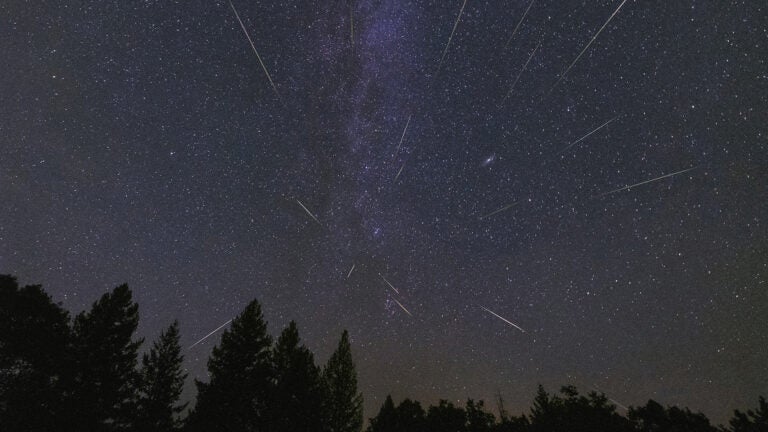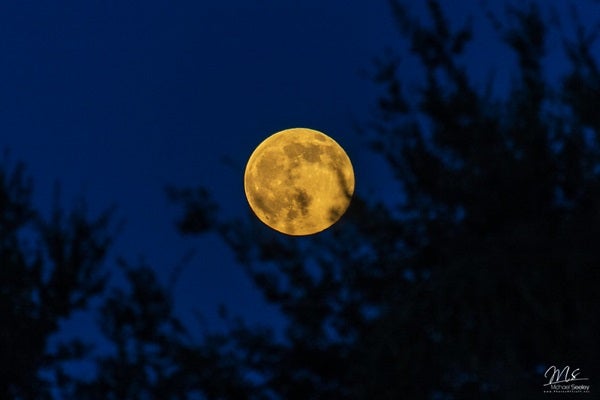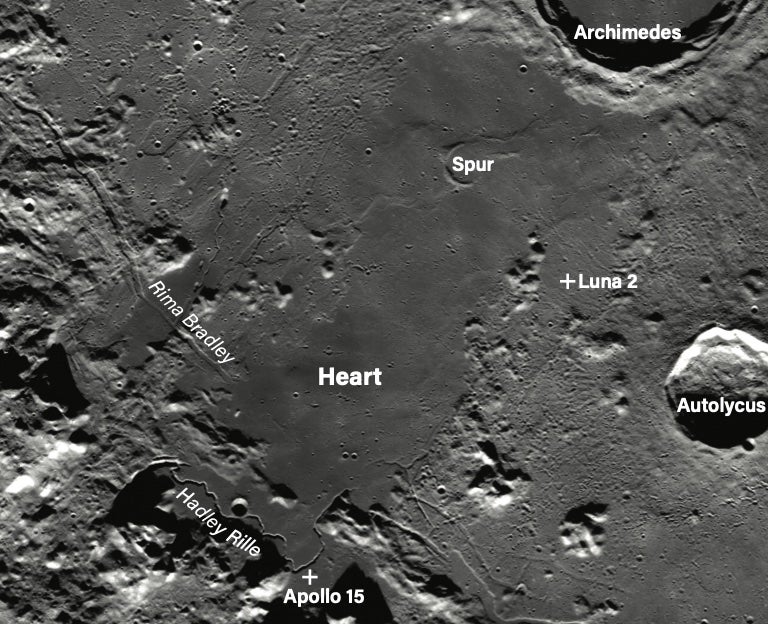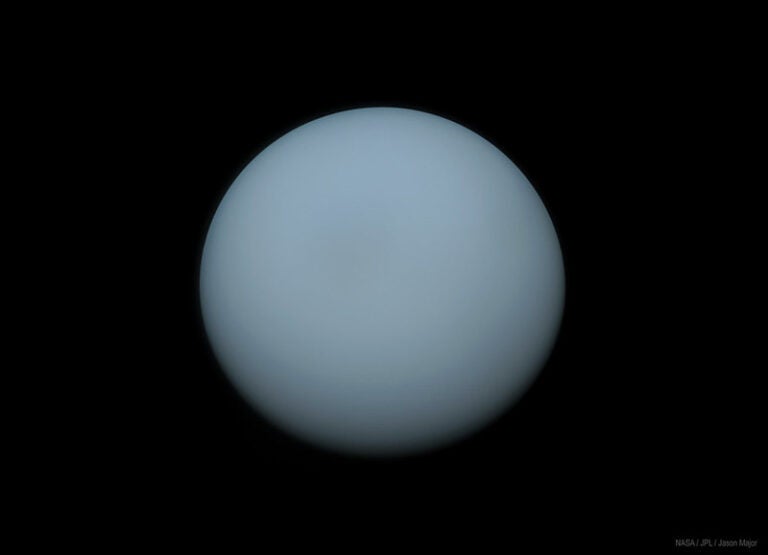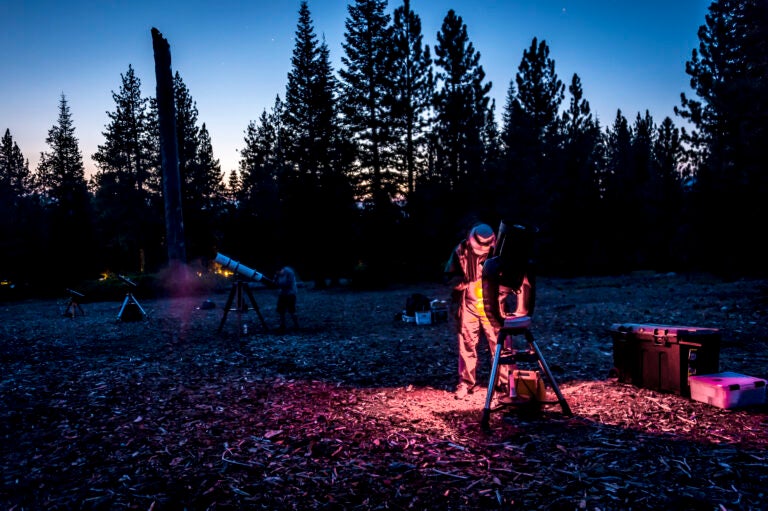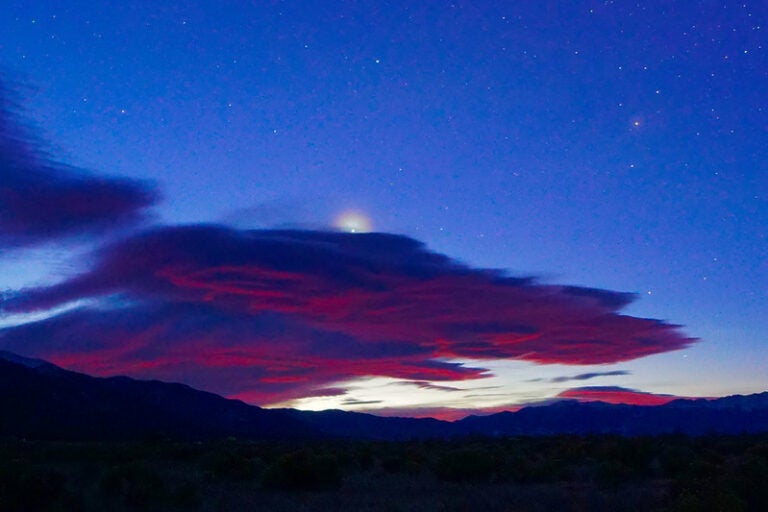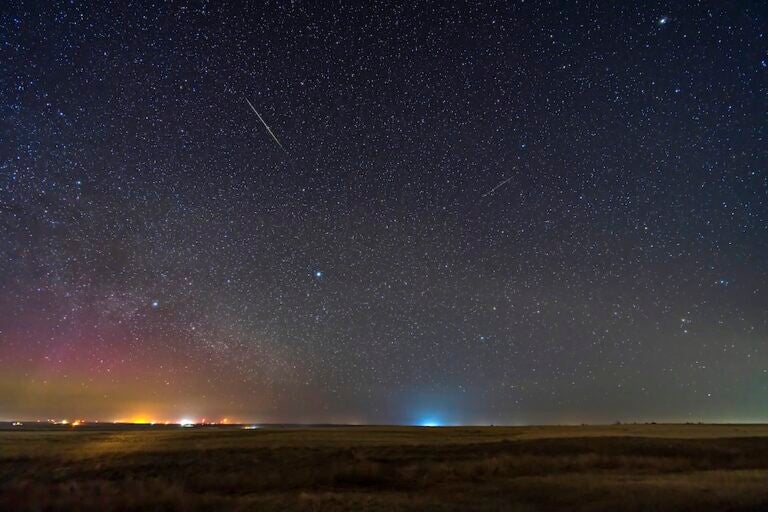
Friday, February 7
Mighty Jupiter stands high in the east at sunset, dominating the stars of Taurus the Bull as they begin to appear in the deepening darkness. Once the Sun is safely below the horizon, center your telescope on the gas giant — those in the eastern half of the U.S. will see the planet and its four Galilean moons spread out, with Io alone to the west and Europa (closest), Ganymede, and Callisto (farthest) to the east.
As the hours pass, Europa is approaching the planet’s southeastern limb, crossing in front of the world starting around 7:10 P.M. EST, as darkness falls across the western half of the U.S. A little over two hours later, around 9:35 p.m. EST, Europa’s shadow appears, less than 10 minutes before the moon itself slips away from the planet’s southwestern limb.
The shadow continues moving east to west, even as Europa pulls away from the planet to the west and Io approaches. The two moons swap places around 10:45 P.M. EST, after which Io closes in on Jupiter’s northwestern limb. The volcanic moon disappears behind Jupiter in an occultation just after 11:20 P.M. EST, while Europa’s shadow finally exits the cloud tops by 12:10 A.M. EST.
Sunrise: 7:02 A.M.
Sunset: 5:27 P.M.
Moonrise: 12:18 P.M.
Moonset: 3:27 A.M.
Moon Phase: Waxing gibbous (76%)
*Times for sunrise, sunset, moonrise, and moonset are given in local time from 40° N 90° W. The Moon’s illumination is given at 12 P.M. local time from the same location.
Saturday, February 8
Let’s return to Taurus and Jupiter in the east this evening as another Galilean moon and shadow transit, letting us witness orbital dynamics in action.
Shortly before 8:30 P.M. EST, Io approaches Jupiter’s southeastern limb, just as Europa did last night. Europa is now far to the planet’s west, with Callisto on the same side, the latter closer in to the gas giant. Ganymede is far to Jupiter’s east.
Io’s transit begins around 8:35 P.M. EST, with its shadow appearing just after 9:45 P.M. EST — note that this is a smaller window between the start of the two transits than last night, when Europa and its shadow were in motion. This opens a window into the jovian system, showing us that Io orbits closer to the planet than Europa.
Io continues sliding across Jupiter’s face from east to west, slipping away from the limb at 10:45 P.M. EST. Around this time, its shadow appears nearly centrally on the disk. Ganymede is now alone to Jupiter’s east, with Io, Callisto, and Europa clustered to the west. Io’s small, dark shadow continues toward the western edge, disappearing at midnight EST.
Sunrise: 7:01 A.M.
Sunset: 5:28 P.M.
Moonrise: 1:17 P.M.
Moonset: 4:31 A.M.
Moon Phase: Waxing gibbous (84%)
Sunday, February 9
Mercury reaches superior conjunction at 7 A.M. EST, meeting with the Sun in the sky. In the coming weeks, the small planet will reappear in our evening sky, approaching Saturn for an evening conjunction in the last week of February.
Tonight, the evening sky holds a different conjunction, as the Moon passes 0.8° north of Mars at 3 P.M. EST and sits near the magnitude 4.1 star Upsilon (υ) Geminorum in the early-evening hours. That star, however, might be hard to see, as our satellite is bright and nearly fully lit, now almost 12 days old with 93 percent of its nearside in daylight.
Just to the Moon’s upper right in the evening sky is Mars. At magnitude –0.9, the Red Planet should be visible even in the bright moonlight; also visible should be 1st-magnitude Castor and Pollux, the heads of the Twins, to the left of the Moon and Mars. Slightly brighter Pollux lies closer to the ground as Gemini rises, with Castor above it.
Through a telescope, Mars now appears 13” across and roughly fully lit. Observers with large scopes and astrophotography experience may be able to capture the massive volcano Olympus Mons and the Tharsis ridge roughly central on the tiny martian disk at around 9 P.M. local time from the central U.S. (look an hour later to the east, and an hour or two earlier to the west).
Sunrise: 7:00 A.M.
Sunset: 5:30 P.M.
Moonrise: 2:23 P.M.
Moonset: 5:26 A.M.
Moon Phase: Waxing gibbous (91%)
Monday, February 10
Saturn’s rings are quickly thinning as the planet tilts relative to our line of sight, preparing for a ring-plane crossing next month. The ringed planet glows at magnitude 1.1 in Aquarius, quickly sinking toward the horizon after sunset. Your best bet for good views is to look shortly after sunset — 40 minutes after the Sun disappears, Saturn is 15° high in the west, hanging below much brighter Venus in Pisces.
Through a telescope, Saturn’s disk spans 16”, while its rings stretch nearly 36” from end to end. Those rings are now tilted toward us by just 2.3°, barely showing off their northern side. It’s a unique view of the planet that will only continue to change as the angle of the rings shrinks throughout the rest of the month, ending February tilted toward us by just 1.3°.
Saturn’s largest moon, Titan, shines at mid-8th magnitude and sits far west of the planet today, some 2’ from the center of Saturn’s disk. Closer to the planet, larger scopes might pick up 10th-magnitude Tethys, Rhea, and Dione in the growing darkness; Dione is east of Saturn, some 30” from the tip of the rings, while Rhea and Tethys are closer to Saturn on its western side. Rhea is just north of the rings tonight for observers in the eastern half of the U.S.; it disappears behind the planet’s northeastern limb in an occultation visible only from the West Coast.
Sunrise: 6:59 A.M.
Sunset: 5:31 P.M.
Moonrise: 3:33 P.M.
Moonset: 6:10 A.M.
Moon Phase: Waxing gibbous (96%)
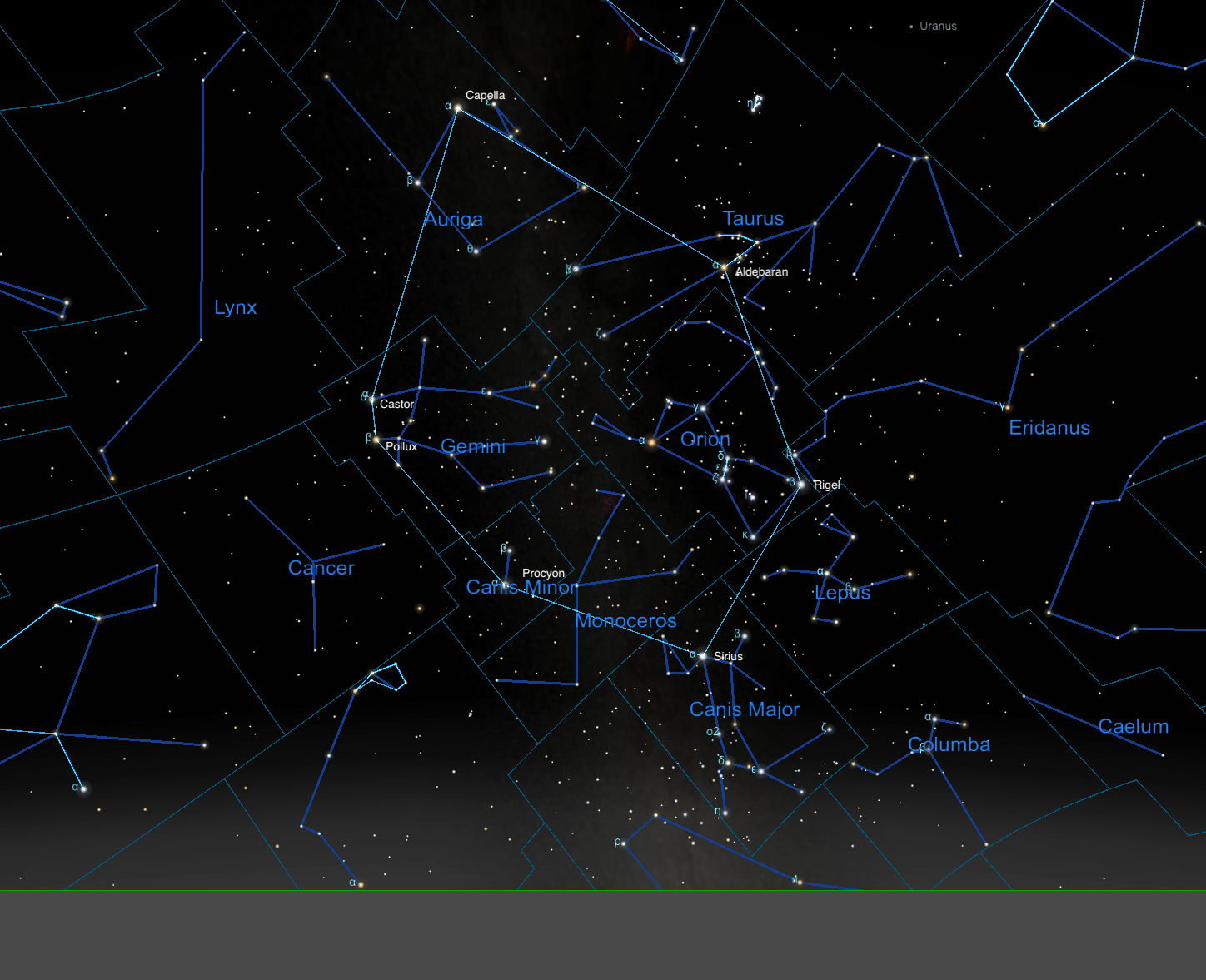
Tuesday, February 11
Although we’ve passed the winter solstice, the Winter Hexagon continues to dominate the evening sky. Spanning six constellations, you can connect the stars of this great asterism as soon as darkness falls from your observing site.
By an hour after sunset, the Winter Hexagon stands prominently in the southeast. Its lowest star is also its brightest: blazing Sirius in Canis Major, at the feet of Orion the Hunter. At magnitude –1.4, Sirius is the brightest star in the sky. Moving counterclockwise up into Orion, the next star in the Hexagon is Rigel, Orion’s magnitude 0.2 right knee (as the Hunter is often drawn facing away from us). From Rigel, look upward to find magnitude 0.9 Aldebaran, the eye of Taurus the Bull. Don’t confuse it with brighter Jupiter, which stands a little above and to the left of this star.
However, do look toward Jupiter — and then continue on in the same direction until you reach the highest star in the Hexagon early in the evening sky: Capella, Auriga’s magnitude 0.1 alpha star. From there, gaze to its lower left, as Castor and Pollux in Gemini — magnitudes 1.6 and 1.2, respectively — together form the next “point.” Finally, look down and slightly right to magnitude 0.4 Procyon in Canis Minor, which is the last stop before the Hexagon closes at Sirius.
Sunrise: 6:57 A.M.
Sunset: 5:32 P.M.
Moonrise: 4:41 P.M.
Moonset: 6:45 A.M.
Moon Phase: Waxing gibbous (99%)
Wednesday, February 12
Full Moon occurs at 8:53 A.M. EST; by evening, the Moon is rising in the east near the front of Leo the Lion shortly after the Sun sets below the western horizon. Our satellite sits just to the left of Regulus, the Lion’s magnitude 1.4 “heart” and the base of the Sickle asterism that outlines the great cat’s head.
The February Full Moon is also called the Snow Moon, likely because this month is typically when North America sees significant snowfall. The Full Moon itself lies opposite the Sun in the sky, and is visible all night, throwing its bright light across the sky. During this phase, many fainter stars become invisible, with only the brightest luminaries shining through.
The parade of planets currently on display features several bright solar system worlds that should still be visible, even in the light of the Full Moon. Early in the evening, Saturn is visible for a little over an hour after sunset, sinking in the west. Above it, Venus dominates Pisces, setting more than three hours after the Sun. Jupiter in Taurus and Mars in Gemini are visible most of the night, remaining above the horizon until the early-morning hours, with Mars disappearing just over an hour before the Sun appears above the eastern horizon tomorrow morning.
Sunrise: 6:56 A.M.
Sunset: 5:33 P.M.
Moonrise: 5:49 P.M.
Moonset: 7:13 A.M.
Moon Phase: Full
Thursday, February 13
Rising just a few hours before the Sun, the Wild Duck Cluster in Scutum is a great target for times when the Moon is bright. Located near the tail of Aquila, this cluster — also cataloged as M11 and NGC 6705 — rises around 3:30 A.M. local time and reaches nearly 25° in altitude in the southeast an hour before sunrise.
Visible with binoculars or any small scope, the larger your aperture, the more stars in this cluster will pop out, particularly with that bright moonlight flooding the sky. The Wild Duck Cluster shines with a total magnitude of about 6, though most of its individual stars fall around 10th magnitude. It spans 14’ on the sky and hangs just under 2° southeast of 4th-magnitude Beta (β) Scuti, or 4° west-southwest of 3rd-magnitude Lambda (λ) Aquilae.
In total, the Wild Duck Cluster holds nearly 3,000 stars and sits more than 6,000 light-years from Earth.
Sunrise: 6:55 A.M.
Sunset: 5:34 P.M.
Moonrise: 6:52 P.M.
Moonset: 7:37 A.M.
Moon Phase: Waning gibbous (99%)
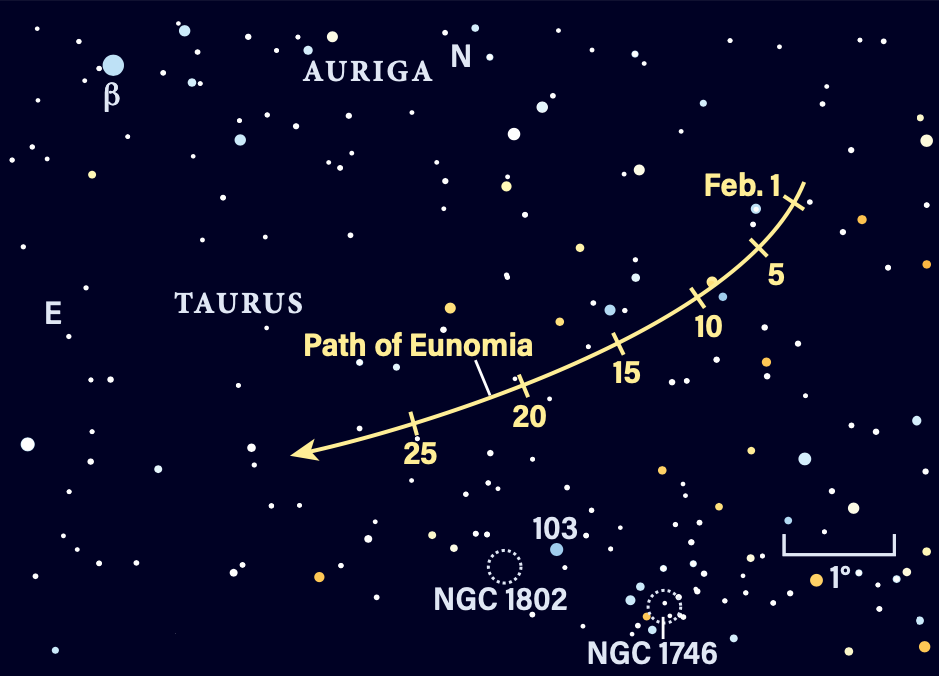
Friday, February 14
The dwarf planet 1 Ceres is in conjunction with the Sun at 5 P.M. EST today. So, let’s focus on another bright main-belt world — 15 Eunomia, which shines at roughly 10th magnitude and stands near 6th-magnitude NGC 1746 in Taurus.
Some 70° high in the east an hour after sunset, Eunomia is perfectly poised for observing during the short dark window before the Moon breaches the horizon. It’s also relatively easy to find, lying roughly halfway between bright Jupiter and magnitude 1.7 Elnath, the tip of the Bull’s “top” horn as its face lies sideways in the sky early in the evening. Elnath, technically cataloged as Beta Aurigae, falls right at the border of Taurus and Auriga.
Tonight, Eunomia is 5.3° southwest of Elnath, in a region relatively free of bright background stars. As a bonus, it is just 2.5° north of NGC 1746. Although classified as an open cluster, astronomers now think this grouping may be more of a chance superposition than a gravitationally bound ball of stars. However, the nearby cluster NGC 1750, which lies less than 7’ to NGC 1746’s south, is likely a true open cluster of associated young suns.
Venus reaches greatest brilliancy this evening at 6 P.M. EST, shining at magnitude –4.9 as a blazing beacon lingering long after sunset. We’ll concentrate our gaze on Earth’s sister planet next week, so stay tuned for more details to come.
Sunrise: 6:54 A.M.
Sunset: 5:35 P.M.
Moonrise: 7:54 P.M.
Moonset: 7:58 A.M.
Moon Phase: Waning gibbous (95%)

Sky This Week is brought to you in part by Celestron.

